Canalis 954-559-5623
- Loudspeakers
- Allegra 2.0
- Amerigo
- Cambria
- Anima
- Anima CS
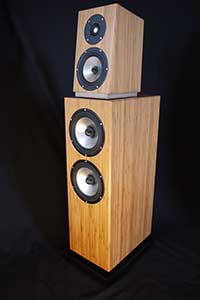
Allegra 2.0
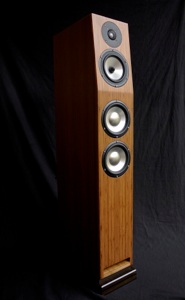
Amerigo
Canalis Loudspeakers
Delivering performance beyond their price, these loudspeakers possess outstanding depth, quiet, presence, and fidelity to perfectly complement all fine audio systems.
To get a sample of the thinking that goes into these speakers, go to the 'support' page of this web site and read Joachim Gerhard's remarks on loudspeaker design. We hope you find them as absorbing as we do!
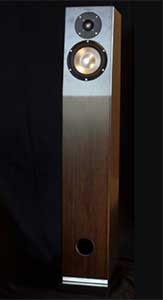
Cambria
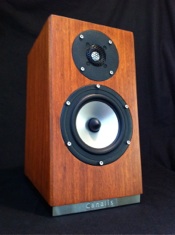
Anima
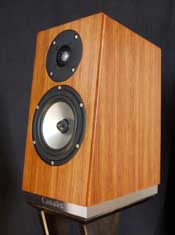
Anima CS
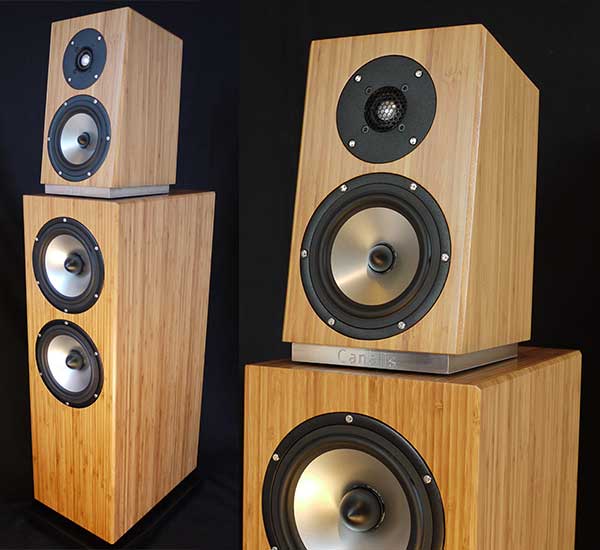
Allegra 2.0
The Allegra 2.0 is our flagship speaker. Designed around the Anima, it is our inspiration for the CS products. To reach our performance goals for this speaker Joachim Gerhard chose to separate the midrange/tweeter cabinet from the bass cabinet, which allowed him to extend the design goal. Separating the cabinets also gave Allen Perkins at Canalis opportunities for mechanical noise reduction and resonance control. Optimization and isolation of the bass and midrange have a lot to do with the Allegra 2.0's effortless performance.
In the midrange/tweeter cabinet, the Allegra 2.0 shares the same driver compliment as the Anima models. Unlike the Anima, the Allegra 2.0 midrange driver is not called upon to reproduce low frequencies. The cabinet shape and internal volume are calculated to get the best performance with a sealed, rather than a ported, box. When testing the Allegra 2.0 it became obvious that the combination of separated bamboo cabinets and Allen's mechanical treatments resulted in a significantly quieter mechanical structure. In fact the Allegro 2.0 surpasses the dynamics and resolution of even the Anima CS, while the bass cabinet delivers a fast and articulate bass response.
The Allegra 2.0 midrange/tweeter cabinet is mass loaded with a hard coupled ¾" stainless steel plate that forms the base of the cabinet. A mechanical decoupling system attaches this high mass assembly atop the bass cabinet. The decoupled mass approach significantly reduces the transfer of bass energy which would otherwise interfere with the midrange/tweeter response. The midrange/tweeter crossover board is securely mounted to the stainless steel base, floating on decoupling material inside the bass cabinet. This arrangement provides an extremely quiet and vibration-free environment for the crossover and significantly aids in lowering the noise floor of the loudspeaker. For the Allegra 2.0 we also upped the parts caliber (and cost) by using only the finest capacitors and custom-designed low-frequency inductors, courtesy of audio engineer Brian Daley.
Driver Technology
The 1" tweeter is a combination metal and soft-dome transducer. Loudspeaker designers, audiophiles, and reviewers, have long debated the merits of metal versus soft-dome. Metal can yield excellent transient response, clarity and high-frequency extension, whereas soft-dome tweeters are often considered to be smoother and sweeter. The tweeter utilizes an extremely light and stiff aluminum-magnesium dome centered in a wide textile surround. (Whereas most metal dome tweeters use aluminum, titanium or titanium-composite construction). This tweeter is distortion-free far beyond the upper range of human hearing. Its large, supple surround allows increased output and lowers the cutoff frequency, which allows very low crossover points to be used.
The midrange cone is the one used in the Anima and the Amerigo models. The cone only begins to distort above 8kHz, well above its operating range in the Allegra 2.0. Designed for dynamic resolution, this driver delivers exceptional definition. The combined result is drastically reduced distortion and increased volume with more expressive dynamics.
The woofer cones in the Allegra 2.0 are ceramic-coated Duraluminum, which is very light and stiff. Incorporating two smaller diameter woofers allows higher output with lower distortion. The separate woofer crossover eliminates all cone resonances so there is no interference with the midrange frequencies. On a subjective level, the bass is highly delineated, with exceptional movement and penetrating power. The cabinet volume is large enough to provide frequencies below 30Hz.
Cabinet Technology
When investigating cabinet material, our goal was to find the ideal balance between beauty and performance. We were not satisfied with the thinly veneered Medium Density Fiberboard (MDF) even though it is relatively inexpensive and easily manufactured. Because MDF is heavy and flexible, the sound pressure generated internally by the drivers turns the entire cabinet into high distortion panels. Instead, we chose three ply, ¾" thick, cross-core Mao Bamboo plywood. Bamboo plywood incorporates multi-dimensional constrained layer damping construction, a naturally quiet material for loudspeaker cabinets. Mao Bamboo, actually a grass, a renewable resource with natural beauty. With custom furniture grade craftsmanship and one of our three finish treatments, there is a Canalis speaker to compliment any decor, from traditional to contemporary. We offer three finishes; Honey, Cinnamon, and Licorice.
Allegra 2.0 Specifications
Speaker type: Three-way, Two-Piece cabinet
Cabinet material: Three-ply, Cross-Grain, Vertical-Core MAO Bamboo, bonded with environmentally-friendly NAUF glue.
Drivers - Woofer: Dual Seas 8" Aluminum Cone woofer. Low mass aluminum voice coil for transient speed and long throw, 20 mm cone travel.
Midrange: Seas 5" Aluminum Cone woofer. Low mass aluminum voice coil for transient speed and long throw, 20 mm cone travel.
Tweeter: Seas .75" High Definition aluminum/magnesium cone. Wide surround for extended low frequency linearity. Coil and windings are optimized for low compression at high power transient peaks.
Internal wiring: Proprietary micro-litz wire for all audio signals.
Single wire connection: Eichmann Bullet Plug Binding Posts.
Crossover: 18 dB Transitional filter. Linear phase, minimal group delay.
Impedance: 8 Ohms
Efficiency: 88 dB/1w/1m&#
Power handling: 180 W
Frequency response: 36Hz \'96 33kHz (-3dB), Crossover Freq. 200Hz, 1.4kHz
Dimensions: 42" H x 10" W x 10.5" D (106.7cm H x 25.4cm W x 26.7cm D)
Weight: 134 lbs. pair. (40.8 kg pr.)

Amerigo
The elegantly proportioned, three-way floorstanding Amerigo introduces design innovations that are unique to this loudspeaker, including the aptly-named Air Drive bass-loading enclosure for extended low-frequency response and improved efficiency.
Amerigo offers true full-range, extremely high-quality sound in rooms where space or other considerations require the use of a speaker with a smaller footprint—while achieving bass definition, integration with the midrange, and treble and tonal accuracy, for natural, evenly-balanced yet articulate sound.
The Air Drive construction employs three separate internal chambers that spread the internal resonance over a variety of frequencies, while controlling the impedance curve that the speaker presents to the amplifier.
A conventional ported speaker typically has one resonance point, creating a large impedance dip. This affects not only the load presented to the amplifier, but causes a frequency response peak at the resonant frequency, which can adversely affect tonal neutrality.
The Amerigo’s three internal chambers create three flatter impedance dips, presenting easier-to-drive loads to the amplifier, thus evening out the frequency response. One of the impedance peaks dips at the low bass frequencies, so more amplifier current and better low-frequency drive is available in the deep bass.
This new type of tuning tightly controls the excursion of the woofers, which move less than in conventional designs. What the listener actually hears is not the woofer cones moving, but the air mass of the loading, hence the name Air Drive. To further refine its performance, the Amerigo’s crossover network includes a proprietary DC circuit that compensates for baffle diffraction and baffle step effects. The Amerigo delivers a surprising amount of bass from a modestly proportioned enclosure with an articulate midrange, exceptionally detailed highs, and a smooth, natural tonal balance with extraordinary clarity.
Cabinet Technology
When investigating cabinet material, our goal was to find the ideal balance between beauty and performance. We were not satisfied with the thinly veneered Medium Density Fiberboard (MDF) even though it is relatively inexpensive and easily manufactured. Because MDF is heavy and flexible, the sound pressure generated internally by the drivers turns the entire cabinet into high distortion panels. Instead, we chose three ply, ¾" thick, cross-core Mao Bamboo plywood. Bamboo plywood incorporates multi-dimensional constrained layer damping construction, a naturally quiet material for loudspeaker cabinets. Mao Bamboo, actually a grass, a renewable resource with natural beauty. With custom furniture grade craftsmanship and one of our three finish treatments, there is a Canalis speaker to compliment any decor, from traditional to contemporary. We offer three finishes; Honey, Cinnamon, and Licorice.
Amerigo Specifications
Speaker type: three-way, Quarter Wavelength Cabinet, Front Port
Cabinet material: MAO Bamboo, bonded with environmentally-friendly NAUF glue.
Drivers: Woofer: two Seas 5” Ceramic layered Aluminum Cone woofer. Low mass aluminum voice coil for transient speed and long-throw, 20 mm cone travel. Mid-woofer: Seas 5¼” Ceramic layered Aluminum Cone woofer. Low mass aluminum voice coil for transient speed and long-throw, 20 mm cone travel.
Tweeter: Seas .75” High Definition aluminum/magnesium cone. Wide surround for extended low frequency linearity. Coil and windings are optimized for low compression at high power transient peaks.
Internal wiring: Proprietary micro-litz wire for all audio signals. Single wire connection, Eichmann Bullet Plug Binding Posts.
Crossover: 18 dB Transitional filter. Linear phase, minimal group delay. Proprietary Joachim Gerhard DC-Module minimizes baffle step bass reduction due to cabinet size.
Impedance: 8 Ohms
Efficiency: 86 dB/1w/1m
Power handling: 250 W
Frequency response: 28Hz – 33kHz (-3dB); Crossover Freq. 400Hz, 1.4kHz
Dimensions: 42”H x 10”W x 10.5”D (106.7cm H x 25.4cm W x 26.7cm D)
Weight: 130 lbs. per pair Estimated (59 kg pr.)
Finishes available are Honey, Cinnamon, and Licorice.

Cambria
The Cambria is the latest design to come from Joachim Gerhard, and it challenges a few rules in loudspeaker design. Not that we’re trying to be tricky. It’s just that when advancements in technology happen, they can open doors that were previously thought to be closed.
The Cambria Low-Frequency Driver
In the Cambria, we have to thank driver manufacturer Seas for their newest 5¼" woofer. This driver is truly an exceptional example of low-frequency driver engineering. In a loudspeaker driver, we want mass to move…fast. And we want it to stop just as fast. In woofers the cone size in part determines its low frequency extension, but more cone area means more mass. More mass adds more inertia, and inertia causes loss of resolution, overhang and smear—sonic distortions to be avoided. That’s where smaller drivers have an advantage over larger drivers… they have less mass and can start and stop faster. The Cambria mid/woofer excels because it has a considerable 30 percent more cone surface area than in a typical driver of the same size.
Seas also developed a new manufacturing technique to make the magnetic flux field controlling the cone’s movement more efficient and linear. This means the driver can travel further, start and stop faster, and remain much more linear than previously possible. What does this mean in real life? For its relatively modest size, this driver can move air like nobody’s business. Faster and with less distortion than ever before. All part of what makes the Cambria an exceptional loudspeaker.
The Cambria cabinet is incorporates a unique quarter-wavelength design. Quarter-wavelength enclosures are usually either a transmission line or a bass reflex (ported) design. The Cambria is a bit of both. It combines a long baffle with a carefully tuned port to create a perfect storm of deep and extended bass response combined with the speed and texture usually associated with small-driver loudspeakers.
The Cambria Tweeter
The 1-inch tweeter is a combination metal and soft-dome transducer. Loudspeaker designers, audiophiles and reviewers have long debated the merits of metal versus soft-dome – metal can yield excellent transient response, clarity and high-frequency extension, whereas soft-dome tweeters are often considered to be smoother and “sweeter.” The Cambria tweeter combines the sonic strengths of both types.
The tweeter utilizes an extremely light and stiff aluminum-magnesium dome centered in a wide textile surround (most metal dome tweeters use aluminum, titanium or titanium-composite construction). The tweeter is distortion-free far beyond the upper range of human hearing. Its large, supple surround allows increased output and lowers the cutoff frequency, which allows very low crossover points to be used. This unique tweeter is one of the key contributing sonic elements of Canalis loudspeakers, and is used in all Canalis models.
Addressing all the details, the Cambria contains premium crossover components, proprietary wiring, and the exceptional Eichmann CablePod™ tellurium copper speaker binding posts.
Cabinet Technology
When investigating cabinet material, our goal was to find the ideal balance between beauty and performance. We were not satisfied with the typical thinly veneered Medium Density Fiberboard (MDF) even though it is relatively inexpensive and easily manufactured. Because MDF is heavy and flexible, the sound pressure generated internally by the drivers turns the entire cabinet into high distortion panels. Instead, we chose remarkable 3-ply, 3/4 inch thick, cross-core Mao Bamboo plywood. Our plywood incorporates multi-dimensional constrained layer damping construction, which results in a naturally quiet material for loudspeaker cabinets. Mao Bamboo, actually a grass, is an efficiently grown renewable resource that is naturally beautiful and elegant. With custom furniture grade craftsmanship and one of our three finish treatments, there is a Canalis speaker to compliment any decor, from traditional to contemporary. The Anima is available in three finishes; Honey, Cinnamon, and Licorice.
Cambria Specifications
Speaker type - Two-way, Quarter Wavelength Cabinet, Front Port
Cabinet material - Three-ply, Cross-Grain, Vertical-Core MAO Bamboo, bonded with environmentally friendly NAUF glue.
Drivers - Woofer: Seas 51/4" Aluminum Cone woofer. Low mass aluminum voice coil for transient speed and long throw, 20mm cone travel.
Tweeter: Seas .75" High Definition aluminum/magnesium cone. Wide surround for extended low frequency linearity. Coil and windings are optimized for low compression at high power transient peaks.
Internal wiring - Proprietary Spiral Groove GrooveLine micro-litz wire for all audio signals. Single wire connection, Eichmann Bullet Plug Binding Posts.
Crossover 18 dB Transitional filter. Linear phase, minimal group delay.
Impedance 8 Ohms
Efficiency 86 dB/1w/1m
Power handling 180 W
Frequency response 39Hz - 33kHz (-3dB)
Crossover Freq. 1.4kHz
Dimensions 42" H x 10" W x 10.5" 4D (106.7cm H x 25.4cm W x 26.7cm D)
Weight 82 lbs. per pair (37.2 kg pair.)
$5,000 per pair,
Finishes - Honey, Cinnamon, and Licorice
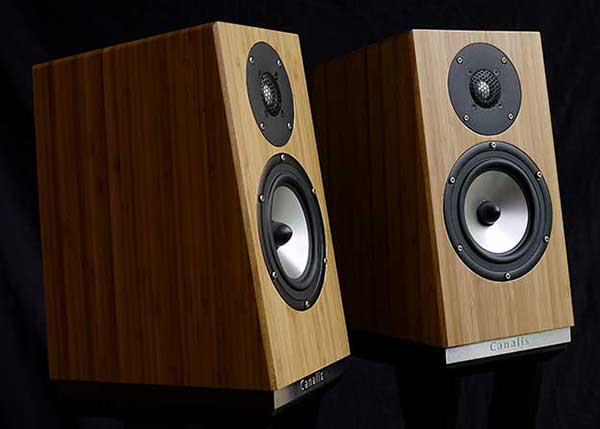
Anima
The Anima is our most popular loudspeaker. This two-way, compact monitor-style speaker has been an audiophile standard for decades, thanks to its ability to present music in a coherent fashion, tonally and spatially.
Designing a two-way loudspeaker is a two-edged sword: it can be a platform for a designer to show his or her mettle or a harshly revealing sonic microscope. Its relative simplicity (compared to multi-driver designs and their more complex crossovers and driver interactions) leaves no room to hide any sonic flaws.
The compact cabinet dimensions make it difficult to control the energy released into the cabinet by the bass driver. Uncontrolled bass energy provides a false sense of low-frequency extension, although it is sonically inaccurate and compromises a speaker's low-frequency texture, articulation and speed.
Musical excellence in a two-way monitor-type speaker is achieved by controlling cabinet resonances, selecting well-chosen, high-quality drivers, and paying precise attention to the crossover design. These sonic strengths are exemplified in the Anima.
The Anima sounds open and spacious with the three-dimensional sonic space that is on the original recording. So neutral is the spectral balance that top mixing studios worldwide have installed the Anima because they can rely on its truthful reproduction of the master recording.
Accurate time domain behavior is vitally important for all aspects of realistic sound reproduction. In a small to medium sized room the Anima provides life-like music reproduction with expressive dynamics and volume levels that belie the speaker's compact size. It is Anima's bass extension, however, that surprises first-time listeners.
To achieve these qualities designer Joachim Gerhard used psychoacoustics principles to encourage the listener's brain to provide what the physics cannot. With a keen understanding of how the human body processes sound, Joachim uses our brain's perception mechanism to our advantage.
Studies have proven that when we hear harmonics associated with a fundamental frequency, our brain re-creates the fundamental frequency as a part of our hearing experience, even when the fundamental frequency is not actually present. For this to occur properly and convincingly, the harmonics must be very accurate. The Anima's harmonic accuracy allows your brain fill in low fundamental frequencies that the speaker cannot actually reach. This is most obvious in the bass region, but is also true through the entire frequency spectrum, and contributes to the solidly authoritative sound of the Anima. This is not a phenomenon that shows up in microphone measurements, but what is more important, measurements or your listening experience? Listen to the Anima and decide for yourself.
Driver Technology
The tweeter is a combination metal and soft dome. In the middle of a very wide textile surround is a compact aluminum-magnesium dome. This dome is very light, stiff and distortion free to frequencies far above human hearing. The large surround allows increased output and lowers the cut-off frequency, which permits very low crossover points. This tweeter is a critical component of the entire Canalis line, being the only component common to all models, regardless of price.
The woofer/midrange cone is uniquely shaped and made with a light but stiff ceramic coated aluminum alloy. The cone only begins to distort above 8kHz, over 6kHz above its operating range in the Anima! Designed for dynamic resolution, this driver delivers truly exceptional definition. The combined result of our efforts is drastically reduced distortion and higher output with more expressive dynamics.
Cabinet Technology
When investigating cabinet material, our goal was to find the ideal balance between beauty and performance. We were not satisfied with thinly veneered Medium Density Fiberboard (MDF), even though it is relatively inexpensive and easily manufactured. MDF is heavy and flexible, so the internal sound pressure generated by the drivers turns the entire cabinet into high-distortion panels. Instead we chose a rather remarkable 3-ply, 3/4 inch thick, cross-core Mao Bamboo plywood. Bamboo plywood introduces multi-dimensional constrained layer damping to cabinet construction. In short, laminated Bamboo is a naturally quiet material for loudspeaker cabinets. Mao Bamboo is actually a grass, an easily-renewable resource that is naturally beautiful and elegant. With custom furniture grade craftsmanship and one of our three finish treatments, there is a Canalis speaker to compliment any decor, from traditional to contemporary. The Anima is available in three finishes: Honey, Cinnamon, and Licorice.
Anima Specifications
Speaker type - 2-way, Bass Reflex, Rear Port
Cabinet material - Three-ply, Cross-Grain, Vertical-Core MAO Bamboo, bonded with environmentally friendly NAUF glue.
Drivers - Woofer: Seas 5 inch Ceramic layered Aluminum Cone woofer. Low mass aluminum voice coil for transient speed and long throw, 20mm cone travel.
Tweeter: Seas .75 inch High Definition aluminum/magnesium cone. Wide surround for extended low frequency linearity. Coil and windings are optimized for low compression at high power transient peaks.
Internal wiring - Proprietary Spiral Groove GrooveLine micro-litz wire for all audio signals. Single wire connection, Eichmann Bullet Plug Binding Posts.
Crossover - 18 dB Transitional filter. Linear phase, minimal group delay.
Proprietary Joachim Gerhard DC-Module minimizes baffle step interaction due to cabinet size.
Impedance - 8 Ohms
Efficiency - 86 dB
Power handling - 120 watts
Frequency response - 44Hz \'96 33kHz (-3dB)
Crossover Freq. 1.9kHz
Dimensions - 16 H x 10 W x 10.5 D (40.6cm H x 25.4cm W x 26.7cm D)
Weight - 28 lbs. per pair (11.34 kg pr.)
Price - $3,250 per pair
Finishes - Honey, Cinnamon, or Licorice
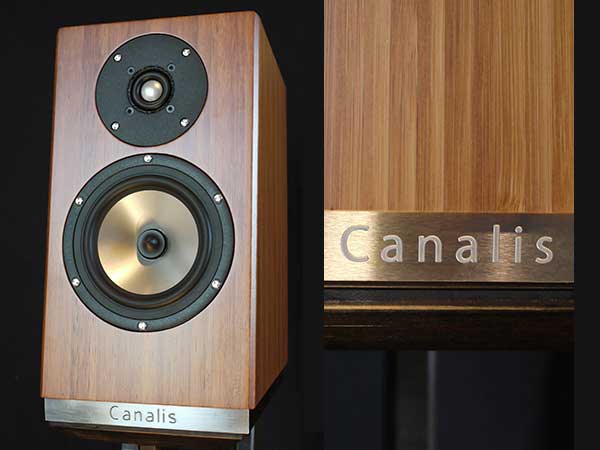
Anima CS
The Anima CS takes the Anima two-way monitor's superlative performance up another level. The improvements? An overall reduction in the noise level of the speaker, higher resolution, and improved dynamics. And what did we do to get these improvements? First of all, the two loudspeakers incorporate the same drivers, bamboo cabinet, crossover topology, premium internal wiring and Eichmann connectors. These highly refined components are the basis for the already excellent performing standard version.
But, the CS version incorporates a number of special noise-reduction treatments (i.e.: Balanced Force Design) and custom parts. The first is a ¾ inch stainless steel base. The significant mass of the stainless steel base, added to the rigid bamboo cabinet, provides a nearly immovable baffle for the speaker drivers. It is also a low vibration platform where the Anima CS crossover is mounted using a floating and decoupled suspension system.
The CS crossover contains only the finest capacitors and hand built low-frequency inductors designed by audio engineer Brian Daley. These are the details that create the low distortion, three-dimensional, high dynamic presentation of the Anima CS. The improved bass extension, clarity and transient response this maximized crossover yields led Allen Perkins to comment that these loudspeakers are not delicate-sounding, but rather deeply nuanced.
It is the Anima CS’ bass extension, however, that surprises first-time listeners. One aspect of CS that this unexpected bass psychoacoustics play a role. Science has shown us that when we hear harmonics associated with a fundamental frequency, our brain will re-create the fundamental frequency as a part of our hearing experience – even though the fundamental frequency is not actually present. Another way to look at this is to consider that a fundamental frequency, like A440, is the same, for example, from a flute or a violin. The reason we can tell its being played by a flute and not a violin is the harmonics above the fundamental.
To achieve these qualities, designer Joachim Gerhard uses psychoacoustics to encourage your brain to provide what physics restricts. With a keen understanding of how we process sound, Joachim uses our brain’s perception mechanism to our advantage. For this effect to be convincing the reproduced harmonic structure must be very accurate. The Anima CS’ harmonic accuracy is such that your brain is able to take the sonic information provided by the loudspeaker and fill in the fundamental where the speaker cannot. This is no more obvious than in the bass region, but it also is true throughout the entire frequency spectrum, and contributes to the “solid” authoritative sound from the Anima CS.
Driver Technology
The 1-inch Anima CS tweeter is a combination metal and soft-dome transducer. Loudspeaker designers, audiophiles and reviewers have long debated the merits of metal versus soft-dome – metal can yield excellent transient response, clarity and high-frequency extension, whereas soft-dome tweeters are often considered to be smoother and “sweeter.” The Anima CS tweeter combines the sonic strengths of both types. It utilizes an extremely light and stiff, aluminum-magnesium dome (most metal dome tweeters use aluminum, titanium or titanium-composite domes) centered in a wide textile surround. The dome is distortion-free to far beyond the upper range of human hearing. Its large, supple surround increases its output and lowers the cutoff frequency, which allows very low crossover points. The Anima CS version of our standard tweeter is modified for even greater resolution.
The Anima CS’ 5¼ inch woofer/midrange cone is made with a light, stiff aluminum alloy, specially shaped to attenuate cone breakup modes that affect midrange and low-frequency clarity. In addition, the cone’s natural breakup mode is far above its operating range. As noted, the woofer incorporates the Canalis custom-designed, noise-reducing low pass coil. This exclusive driver delivers remarkable definition and wide dynamics.
Cabinet Technology
When investigating cabinet material, our goal was to find the ideal balance between beauty and performance. We were not satisfied with the thinly veneered Medium Density Fiberboard (MDF), which is often chosen for its low price and easy manufacturability. Because MDF is heavy and flexible, the sound pressure generated internally by the drivers turns the entire cabinet into a high distortion speaker. Instead, we chose remarkable 3-ply cross-core Mao Bamboo 3/4” plywood. Our plywood incorporates a multi-dimensional constrained layer damping construction, which makes a naturally quiet material for loudspeaker cabinets. Mao Bamboo, actually a grass, is an efficiently grown renewable resource that is naturally beautiful and elegant. With custom furniture-grade craftsmanship and three finishes; Honey, Cinnamon, and Licorice, the Anima CS will compliment any decor, from traditional to contemporary.
Anima CS Specifications
Speaker type - 2-way, Bass Reflex, Rear Port
Cabinet material - 3ply, Cross-Grain, Vertical-Core MAO Bamboo, bonded with environmentally friendly NAUF glue.
Base - 3/4 Stainless Steel hard mounted to the bamboo cabinet to provide significant mass loading for energy dissipation. Three 1/4 - 20 threaded holes for mounting to speaker stand.
Drivers - Woofer: Seas 5 Ceramic layered Aluminum Cone woofer. Low mass aluminum voice coil for transient speed and long throw, 20mm cone travel.
Tweeter: Seas 3/4 High Definition aluminum/magnesium cone. Wide surround for extended low frequency linearity. Coil and windings are optimized for low compression at high power transient peaks.
Internal wiring - Proprietary Spiral Groove GrooveLine micro-litz wire for all audio signals. Single wire connection, Eichmann Bullet Plug Binding Posts.
Crossover - 18 dB Transitional filter. Linear phase, minimal group delay.
Proprietary Joachim Gerhard DC-Module minimizes baffle step interaction due to cabinet size. Decoupled mounting technique for isolation from cabinet and driver energy. Teflon capacitors and custom designed and wound Spiral Groove woofer coil.
Impedance - 8 Ohms
Efficiency - 86 dB
Power handling - 120 W
Frequency response - 44Hz - 33kHz (-3dB)
Crossover Freq. 1.9kHz
Dimensions - 16 H x 10 W x 10.5 D (40.6cm H x 25.4cm W x 26.7cm D)
Weight - 48 lbs. pr. (21.8 kg pr.)
Price - $6,000 per pair
Finishes - Honey, Cinnamon, or Licorice